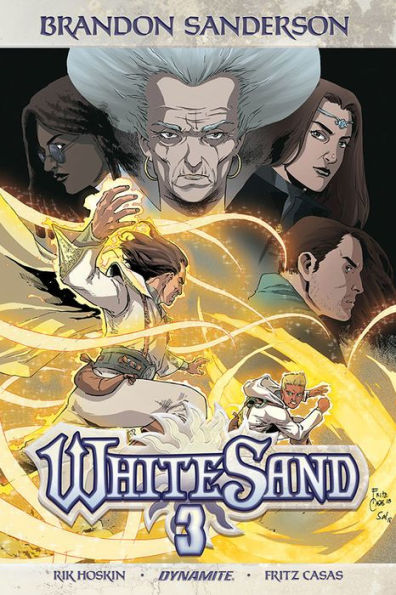Brandon Sanderson is one of the biggest names in genre fiction right now. His young adult offerings, ranging from The Reckoners to Skyward to The Rithmatist, have attracted hordes of ardent fans. His adult fantasy set in the Cosmere universe features the heralded Stormlight Archive and six (and counting) installments under the Mistborn title, including multiple bestsellers. Warbreaker and Elantris are standalones (for now) with plenty of enthusiastic supporters. Even some of the shorter stories in the Cosmere—like the Hugo Award-winning The Emperor’s Soul—are well-known.
But seemingly lost in this impressive mix is White Sand, chronologically the earliest currently-published work in the Cosmere.
Perhaps it’s because of the medium: White Sand is published as a graphic novel, with two of the three volumes already released and the third and final installment currently on its way, scheduled for release on September 10, 2019. There have been delays and various issues with the artists, resulting in a change midway through Volume 2; many readers noted the dramatic alteration in style during the latter pages of that installment. Whatever the reason, it seems to me that White Sand simply doesn’t get the love from Sanderson fans that it so clearly deserves.
First and foremost, White Sand is the deepest look yet at a pivotal character in the Cosmere: the renowned scholar Khrissalla, author of the Ars Arcana that appear at the end of every Cosmere novel and the voice behind the illuminating essays in Arcanum Unbounded.
A duchess from the Dark Side of Taldain—a tidally locked world—Khriss finds her way in a new culture and sets off down the path that will lead to her becoming the single most knowledgeable character in the Cosmere so far.
Like Jasnah from The Stormlight Archive, Khriss is an astute scholar with a keen intellect and an ability to dig into the deeper principles behind the magic of the Cosmere. Unlike Jasnah, however, Khriss is young and filled with exuberance; she’s demonstrative and in many ways wears her heart on her sleeve. Mostly, the Duchess Khrissalla is an unabashed nerd…and it’s fantastic.
While the graphic novel editions of White Sand mostly concentrate on the character of Kenton—one of the few remaining Sand Masters—and on his quest to save his order from legal extinction, they do spend time with Khriss (and Ais, a foreigner who has become essentially a police sergeant).
But it’s in Sanderson’s rough draft of the original novel (available for free with a subscription to Sanderson’s newsletter) that Khriss shines most intensely. Here, the prose format allows the reader into Khriss’s head, giving insight into her thought processes and illuminating how a young Duchess could eventually evolve into the preeminent scholar we see writing about the worlds and magics. Her wonder at new cultures, thirst for experimentation and understanding, and insistence on solving the mysteries behind the magic on Taldain all combine to make a refreshing—and spunky—character.
While the prose version is not canon—there are a few notable changes from the prose to the published graphic novels—it remains mostly true to the story, and true to Khriss’s character.
But Khriss is not the only worldhopper from Taldain. Another character, of an altogether different type, makes an appearance elsewhere in the Cosmere: the looming, efficient Baon. Many fans have found the point where he resurfaces in another book, but it’s not the easiest cameo to pick up on. (Just keep an eye out for gruff, blunt characters.) Moreover, there is another character, one whose name should flash giant red lights at any Cosmere fan: Trell. This foreman, seemingly inconsequential in White Sand, remains shrouded in mystery—but the impact of his name is undeniable across the Cosmere.
Buy the Book


Brandon Sanderson’s White Sand Volume 3
While most fans’ lists of favorite characters in the Cosmere might predictably include the likes of Kelsier, Kaladin, Sazed, Jasnah, and Dalinar—major players in Sanderson’s two best-known series—the cast of White Sand is every bit as colorful and entertaining. Whether it’s Aarik (or ‘Eric’ in the original prose version), the Sand Master Drile, the irrepressible Lord Admiral Delious, or the erratic and threatening Nilto, the supporting characters are intriguing and carve out their own memorable places on the page.
The magic of White Sand, too, holds a unique place among Sanderson’s fiction. As one of the earliest Invested Arts in his work, Sand Mastery acts in sometimes strange ways in accordance with the normal rules of Investiture. It’s an eminently visual magic—part of the reason the story works so well in the graphic novel format—and has a wide range of uses, even on other worlds. Indeed, vials of sand from Taldain make appearances in The Stormlight Archive.
The plot of White Sand is largely political, though things are coming to a head at the end of Volume 2, setting up a number of intriguing threads to be resolved in the final installment of the story. Kenton faces numerous obstacles in his path to preserving the Diem and the Sand Masters—both within the Diem itself and among the political rulers of the Taisha. Meanwhile, Khriss still seeks answers about the “sand mages” and her long-lost betrothed, Prince Gevalden of Elis.
And perhaps most important of all? Looming in the background is the inscrutable Shard of Autonomy, whose hand seems to have left indelible marks in far-reaching events across the Cosmere….
Drew McCaffrey lives in Fort Collins, CO, where he’s spoiled by all the amazing craft beer. He co-hosts the Inking Out Loud podcast, covering science fiction and fantasy books (and some of that Colorado craft beer). You can find him on Twitter, talking about books and writing, but mostly just getting worked up about the New York Rangers.










